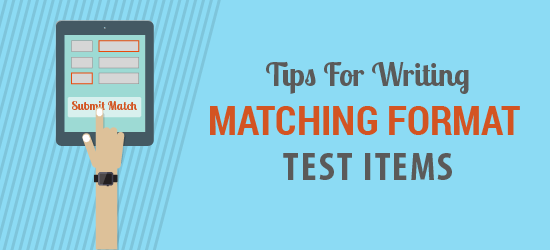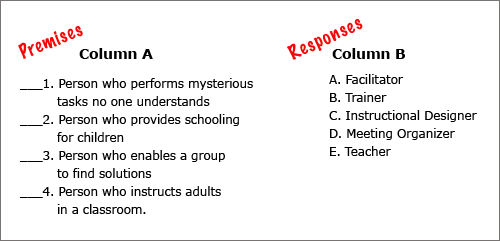Tips For Writing Matching Format Test Items
Source http://theelearningcoach.com/elearning_design/writing-matching-test-items/
Source

When you write test items in a matching format, do you stress about which terms should go on the left and which on the right? Are you puzzled about when to use the matching format and whether multiple choice would be better?
Here are some answers to these perplexing issues.
The Matching Format
The matching test item format provides a way for learners to connect a word, sentence or phrase in one column to a corresponding word, sentence or phrase in a second column. The items in the first column are called premises and the answers in the second column are the responses. The convention is for learners to match the premise on the left with a given response on the right. By convention, the items in Column A are numbered and the items in Column B are labeled with capital letters.

Many authoring tools come with a pre-built matching test item template, which may involve dragging responses to the premise or typing the letters from Column B into Column A. The authoring tool templates may vary from the conventions of the written format.
When to Use Matching
The matching test item format provides a change of pace, particularly for self-check and review activities. Many instructional designers employ them in quizzes and tests too. They are effective when you need to measure the learner’s ability to identify the relationship or association between similar items. They work best when the course content has many parallel concepts, for example:
- Terms and Definitions
- Objects or Pictures and Labels
- Symbols and Proper Names
- Causes and Effects
- Scenarios and Responses
- Principles and Scenarios to which they apply
Construction Guidelines
If you decide to use a matching format, take the time to construct items that are valid and reliable. Here are some guidelines for this.
1. Two-part directions. Your clear directions at the start of each question need two parts: 1) how to make the match and 2) the basis for matching the response with the premise. You can also include whether items can be re-used, but often pre-built templates don’t allow for this.
Example for exercise above: Drag each career name in Column B to the best definition in Column A. No items may be used more than once.
2. Parallel content. Within one matching test item, use a common approach, such as all terms and definitions or all principles and the scenarios to which they apply.
3. Plausible answers. All responses in Column B should be plausible answers to the premises in Column A. Otherwise, the test loses some of its reliability because some answers will be “give-aways.”
4. Clueless. Ensure your premises don’t include hints through grammar (like implying the answer must be plural) or hints from word choice (like using the term itself in a definition).
5. Unequal responses. In an ideal world, you should present more responses than premises, so the remaining responses don’t work as hints to the correct answer. This is not often possible when using a template.
6. Limited premises. Due to the capacity limitations of working memory, avoid a long list of premises in the first column. A number that I’ve come across is to keep the list down to six items. Even less might be better, depending on the characteristics of your audience.
7. One correct answer. Every premise should have only one correct response. Obvious, but triple-check to make sure each response can only work for one premise.
Pros and Cons
The matching test item format allows you to cover more content in one question than you can with multiple choice. That’s why I think they are excellent for intermittent knowledge checks. They are also a very efficient approach to testing and can provide an excellent objective measurement. In addition, they provide a way to add some variety to your activities.
A disadvantage is the tendency to use this format for the simple recall of information. Adult learners often require practice and testing of higher-order thinking skills, such as problem solving. Don’t limit your use of this format to recall of knowledge alone. Rather, try to find ways to use matching for application and analysis too, such as presenting a short scenario and asking for the best solution.
When using matching test items in an assessment, you’ll need to identify the specifics of how they will be scored. Some prefer to give partial credit when some—but not all—of the responses are correct. Often, the authoring tool determines the approach, but if you do have control, it’s an issue you’ll need to explore.
Related Articles:
Are your online tests reliable?Are your online tests valid?10 Rules For Writing Multiple Choice Questions
